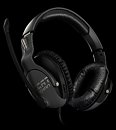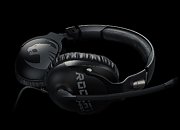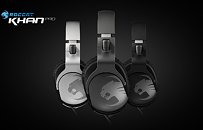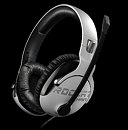Tuesday, October 17th 2017

Roccat Announces the Khan Pro Gaming Headset
ROCCAT is proud to announce that its newest stereo gaming headset, the Khan Pro, is now available across all major channels. The suggested retail price is $99.99. The Khan Pro is the first gaming headset in the world granted the Hi-Res Audio certificate, given only to the very best audio products on the market. With its remarkable sound clarity, the player can hear and locate any opponent long before they come in sight. With a broad frequency range between 20Hz and 40kHz, the Khan Pro boasts deep bass, rich mids and clear highs, enabling gamers to enjoy unrivalled sound. The Khan Pro makes every gamer a winner.
The Khan Pro also features a Real-Voice mic, offering the most natural voice transmission deliverable in a gaming headset. The microphone of the Khan Pro can pick up lower frequencies than competitors in its class. This expanded spectrum makes the human voice sound as natural as possible on a gaming headset, optimizing team communication like never before, and ensuring commands and callouts are crystal clear.The low weight of the Khan Pro in combination with its memory foam earpads makes it the perfect partner for long play sessions. It doesn't matter if you're racing for a World First Kill in World of Warcraft or the Global Elite in Counter-Strike: Global Offensive - it will never get uncomfortable no matter the duration of play. The Khan Pro is the choice for ambitious esport gamers and all those who aspire to become a better player in general. Play like a pro - with the ROCCAT Khan Pro.
For more information, visit the product page.
The Khan Pro also features a Real-Voice mic, offering the most natural voice transmission deliverable in a gaming headset. The microphone of the Khan Pro can pick up lower frequencies than competitors in its class. This expanded spectrum makes the human voice sound as natural as possible on a gaming headset, optimizing team communication like never before, and ensuring commands and callouts are crystal clear.The low weight of the Khan Pro in combination with its memory foam earpads makes it the perfect partner for long play sessions. It doesn't matter if you're racing for a World First Kill in World of Warcraft or the Global Elite in Counter-Strike: Global Offensive - it will never get uncomfortable no matter the duration of play. The Khan Pro is the choice for ambitious esport gamers and all those who aspire to become a better player in general. Play like a pro - with the ROCCAT Khan Pro.
For more information, visit the product page.





11 Comments on Roccat Announces the Khan Pro Gaming Headset
It truly looks like someone is recruiting the dumbest of the dumbest to come up with this release announcements.
And while I'm aware of digital sampling differences, it's still essentially just that. We do perceive differences in audio even when frequencies go beyond our physical hearing range.
You're mixing digital and analog here. The human ear can (sometimes) pick up the analog 20kHz signal. In order to reconstruct that signal, you need digital samples that go as high as 40kHz. That's why CDs are burnt at 44kHz: to offer perfect reconstruction of a 22kHz analog signal. Now, if you take a 44kHz CD and downsample it, you've just thrown away a good chunk of useful info. But that doesn't mean you could hear 30 or 40kHz before, it simply means the 20kHz signal you could hear, cannot be reconstructed as well as before.